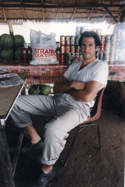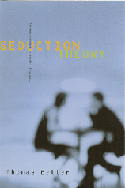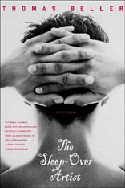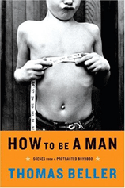BOOKS
Proof Positive That Thomas Beller Has Begun Manhood
August 14, 2005
By CAROLE GOLDBERG, Courant Books Editor
Come with Thomas Beller as he strides onto the observation deck of life,
and see what he sees:
A mint-green 1977 Thunderbird with "almost feline weight and power,
nimble but bordering on sloth" and "a giant, majestic, overlong,
preposterous nose."
•The heretofore un-remarked-upon similarities between a rock band
drummer (which Beller once was) and dogs: "Dogs: reliable. Drummers:
same. Dogs: fun and friendly, but capable of sudden and shocking acts
of lewd behavior. Drummers: same. Dogs: playful and frolicsome until told
to heel. Drummers: same."
•Gifts of clothing from a girlfriend out to remake him: "I
was being gently nudged into the realm of slightly studied scruffiness...
like going to the style chiropractor and getting realigned."
•The painful end of an affair: "... like the longest, slowest
removal of a Band-Aid ever, each torn follicle its own little death."
•A rehab center with a brisk program for sex addicts: "This
place was to psychoanalysis what Evelyn Wood is to reading."
Each essay in Beller's collection "How To Be a Man: Scenes From a
Protracted Boyhood" sparkles with such apercús - elegant descriptions
and sophisticated insights that evince the hipness you expect from a lifelong
New Yorker and a sweetness and intimacy you might not.
Beller, author of the novel "The Sleep-Over Artist" and the
story collection "Seduction Theory," also founded Open City,
which publishes a magazine and books and hosts the website www.mrbellersneighborhood.com.
Postings to it about life in the Big Apple before and immediately after
the Sept. 11 terrorist attacks were selected by Beller for "Before
and After: Stories From New York." Published in 2001 in two sections
with separate covers - the second shows the burning towers - it's a chronicle
of life in '90s New York, the attacks and their aftermath, by writers
such as Michael Cunningham and Philip Lopate and less well-known Manhattanites.
"How To Be a Man" comprises essays by Beller, many of which
first appeared in The New Yorker, The New York Times, Slate, Elle and
other journals. Each one, duly annotated with his age at the time of the
experience, is a chip in the mosaic of his life, from early memories of
the father he lost at age 9 to the musing of the 39-year-old at last sure
enough of himself to commit to marriage.
We learn about growing up in an apartment building, a freestanding, enclosed
neighborhood. We watch him playing street basketball, with its distinct
rituals and characters.
We experience life inside a bagel factory run by a Puerto Rican convert
to Judaism, where flour wafts through the air and ever-so-lightly powders
the employees, where water pours through a pipe 24/7 to cool the bagel-making
machinery, where accounts are kept in a "huge, decrepit, almost biblical-looking
ledger book ... filled with tiny numerical entrees." And where the
inventory guy, namely Beller, must never, ever forget to stock enough
brown sugar for the secret recipe - but of course does.
And we walk into a strip club, where "the shock of the moment is
the shock of the new. All day long you are surrounded by unknown breasts
... and suddenly the curtain is lifted, and the mystery revealed."
Strip joints, says Beller, are "the last men's club," where
"the most fun to be had is with other guys." Their "paradoxical
reality" is that they are "one of the few remaining places men
can go to not think about women."
Beller does think - a lot - about women and about how relationships go
bad:
"Courage in relationships is often seen in terms of having the strength
to walk away from a bad situation," he writes. "But it's much
harder to walk away from a good situation, one in which the current moment
is sweet, and yet you never let go of the feeling that this is just a
visit, temporary."
That kind of insight seems proof positive that the protracted boyhood
is over, and manhood has begun.
Reach Carole Goldberg at cgoldberg@courant.com
|







